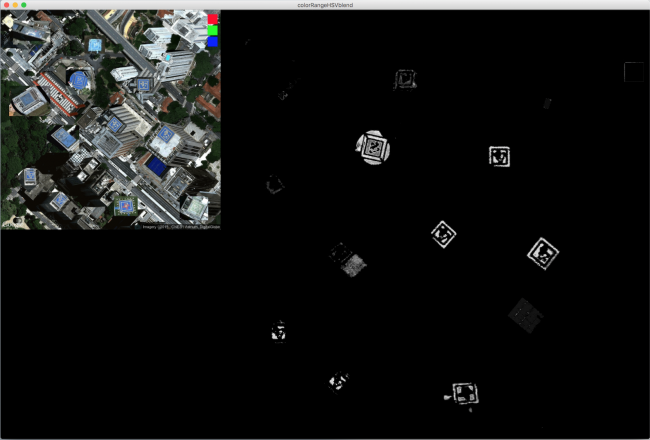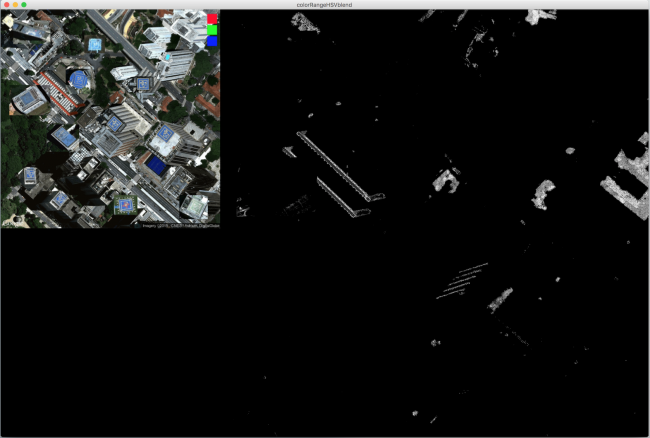I use a shader to select a color.
Here it is for blueish for example:

Here for redish:

Now I wan't to blend the 2 in a LIGHTEST kind of fashion.
I tried blend(img, 0, 0, 512, 512, 0, 0, 512, 512, LIGHTEST); but as expected this doesn't work.
Even worse, it makes crash JRE a lot it seems! (Is this a processing bug?).
What would be a good way to blend those results? I'm looking for a solution that is scalable (so also use the color select for 7 colors for example).
If possible: -a fast solution (so gpu prefered) -no edits to the current shader (if that makes sense to do)
PImage img;
PShader shader;
void settings() {
size(1512, 1000, P2D);
}
float[] targetColorRGB = new float[] {0.2, 0.4, 0.7};
float fuzzinessH = 0.1;
float fuzzinessS = 0.3;
float fuzzinessV = 0.3;
// for 2nd color:
float[] targetColor2RGB = new float[] {0.5, 0.3, 0.2};
float fuzziness2H = 0.1;
float fuzziness2S = 0.3;
float fuzziness2V = 0.3;
void setup() {
img = loadImage("http://" + "localhost:8888/catalogtree/helipad_detection/testImg2.png");
shader = loadShader("http://" + "localhost:8888/shaders/colorRangeHSV.glsl");
colorMode(RGB, 1, 1, 1, 1);
}
void draw() {
background(0);
shader(shader);
shader.set("targetColor", targetColorRGB, 3);
shader.set("fuzzinessH", fuzzinessH);
shader.set("fuzzinessS", fuzzinessS);
shader.set("fuzzinessV", fuzzinessV);
image(img, 512, 0, height, height);
//resetShader();
// now apply the shader again with different settings
shader(shader);
shader.set("targetColor", targetColor2RGB, 3);
shader.set("fuzzinessH", fuzziness2H);
shader.set("fuzzinessS", fuzziness2S);
shader.set("fuzzinessV", fuzziness2V);
//image(img, 512, 0, height, height);
// this also makes crash JRE a lot!
blend(img, 0, 0, 512, 512, 0, 0, 512, 512, LIGHTEST);
resetShader();
// the original
image(img, 0, 0, 512, 512);
}
The shader:
#ifdef GL_ES
precision mediump float;
precision mediump int;
#endif
#define PROCESSING_TEXTURE_SHADER
uniform sampler2D texture;
varying vec4 vertTexCoord;
// excepts a color in RGB
uniform vec3 targetColor;
uniform float fuzzinessH;
uniform float fuzzinessS;
uniform float fuzzinessV;
// . . . . . . . . . . . . . . . . . . . . . . . . . . . . . . . . . . . . . . .
float norm(in float value, in float start, in float stop) {
return (value - start) / (stop - start);
}
// . . . . . . . . . . . . . . . . . . . . . . . . . . . . . . . . . . . . . . .
vec3 rgb2hsv(vec3 c)
{
vec4 K = vec4(0.0, -1.0 / 3.0, 2.0 / 3.0, -1.0);
vec4 p = mix(vec4(c.bg, K.wz), vec4(c.gb, K.xy), step(c.b, c.g));
vec4 q = mix(vec4(p.xyw, c.r), vec4(c.r, p.yzx), step(p.x, c.r));
float d = q.x - min(q.w, q.y);
float e = 1.0e-10;
return vec3(abs(q.z + (q.w - q.y) / (6.0 * d + e)), d / (q.x + e), q.x);
}
// . . . . . . . . . . . . . . . . . . . . . . . . . . . . . . . . . . . . . . .
vec3 hsv2rgb(vec3 c)
{
vec4 K = vec4(1.0, 2.0 / 3.0, 1.0 / 3.0, 3.0);
vec3 p = abs(fract(c.xxx + K.xyz) * 6.0 - K.www);
return c.z * mix(K.xxx, clamp(p - K.xxx, 0.0, 1.0), c.y);
}
// . . . . . . . . . . . . . . . . . . . . . . . . . . . . . . . . . . . . . . .
void main() {
vec3 texColor = texture2D(texture, vertTexCoord.st).rgb;
vec3 hsvTexColor = rgb2hsv(texColor);
vec3 hsvTargetColor = rgb2hsv(targetColor);
float distanceH = distance(hsvTexColor.r, hsvTargetColor.r);
float distanceS = distance(hsvTexColor.g, hsvTargetColor.g);
float distanceV = distance(hsvTexColor.b, hsvTargetColor.b);
/*
vec3 result;
if (distanceH < fuzzinessH && distanceS < fuzzinessS && distanceV < fuzzinessV) {
float normH = norm(distanceH, fuzzinessH, 0);
float normS = norm(distanceS, fuzzinessS, 0);
float normV = norm(distanceV, fuzzinessV, 0);
result = vec3(min(normH, min(normS, normV)));
}
else {
result = vec3(0);
}
*/
// the result looks the same without any if statements
// so we go for that cause shaders without if statements tend to be faster!
float normH = norm(distanceH, fuzzinessH, 0);
float normS = norm(distanceS, fuzzinessS, 0);
float normV = norm(distanceV, fuzzinessV, 0);
vec3 result = vec3(min(normH, min(normS, normV)));
gl_FragColor = vec4(result, 1.0);
}
// . . . . . . . . . . . . . . . . . . . . . . . . . . . . . . . . . . . . . . .